The Sago Palm, scientifically known as Cycas revoluta, may not be a true palm tree, but it certainly possesses the same elegant charm. With its symmetrical ring of spiky, glossy, dark green fronds, this slow-growing plant is a popular choice for both indoor and outdoor decoration.
When caring for your Sago Palm, it’s essential to create the ideal environment. These plants prefer warm, humid conditions with dappled sunlight. They thrive in acidic soil and require consistent temperatures between 65 and 75 degrees Fahrenheit. Whether you choose to grow your Sago Palm indoors or outdoors, it’s important to note that all parts of the plant are toxic to humans and pets, so caution should be exercised.
Throughout this guide, we will delve into various aspects of Sago Palm care, including light requirements, watering techniques, fertilizing tips, potting recommendations, propagation methods, and more. We’ll also touch on the growth and development of these majestic plants and common pests and diseases to watch out for.
The Appearance of Sago Palms

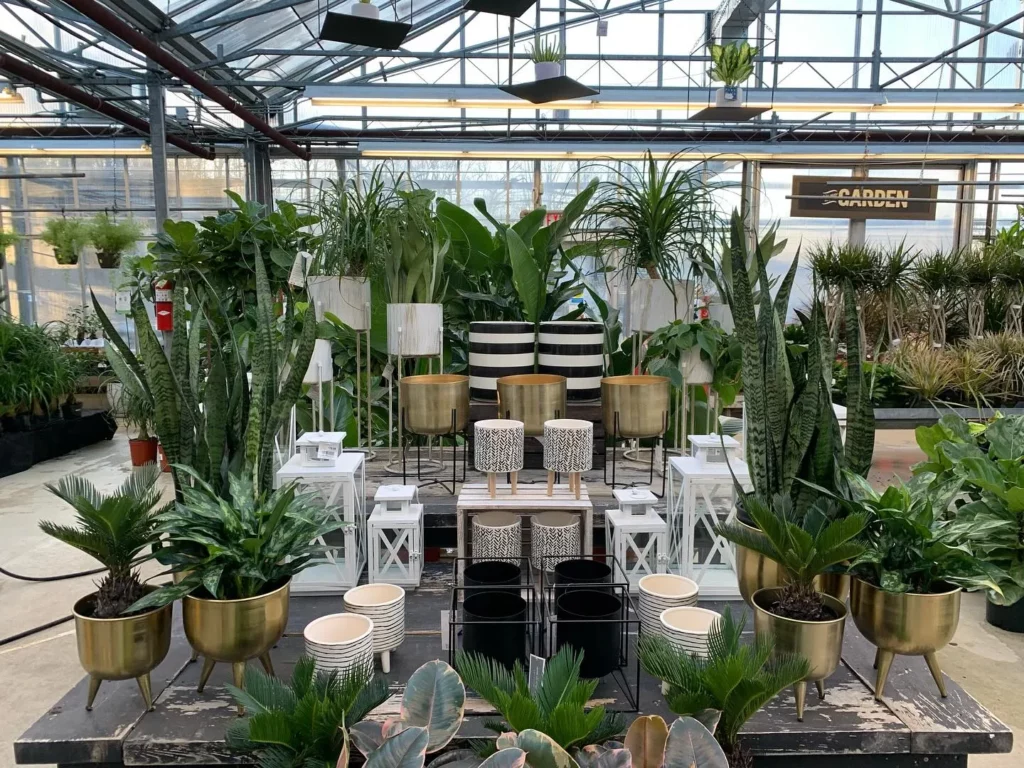

The most prominent feature of a Sago Palm is its green fronds. These fronds are long, elegant, and gracefully arching, adding a touch of tropical charm to any space they inhabit. The fronds grow in a symmetrical ring formation, emanating from a non-branching trunk.
| Feature | Description |
|---|---|
| Fronds | Long, green, and gracefully arching fronds that grow in a symmetrical ring pattern. |
| Trunk | A non-branching trunk that serves as the main support for the fronds. |
| Leaf Appearance | Spiky, glossy, and dark green leaves that add texture and depth to the plant. |
| New Growth | Bronze, feather-like foliage emerges as new growth, showcasing the beauty of the cycad. |
While Sago Palms can grow up to 10 feet or more when planted in the ground, they tend to stay smaller when grown in containers, usually reaching heights of 2 to 3 feet. This makes them suitable for both indoor and outdoor decor, allowing you to bring a touch of the tropics to even the smallest spaces.
The attractive and symmetrical appearance of Sago Palms makes them a popular choice for landscaping projects, gardens, and even as focal points indoors. Whether you feature them as standalone plants or group them with other tropical species, Sago Palms are sure to make a visual impact.
Light Requirements for Sago Palms

Proper light is essential for the healthy growth of Sago Palms. These plants thrive in bright, indirect light, making them suitable for both indoor and outdoor environments. When positioning your Sago Palm indoors, try to place it near windows facing east, west, or south. This will allow the plant to receive adequate light throughout the day.
Outdoors, it’s important to find a sunny spot for your Sago Palm. However, direct sunlight all day can scorch the leaves, so providing some partial shade is recommended. This will protect the plant from excessive heat and maintain its vibrant appearance.
Maintaining the right balance between light and shade is crucial. Too much shade can lead to sparse foliage and an unhealthy plant. On the other hand, too much direct sunlight can cause leaf burn and damage.
If you’re growing your Sago Palm as an indoor plant, you can take advantage of warm weather by moving it outside. However, make sure to place it in an area with dappled sunlight. This will provide the perfect balance of light and shade, allowing the plant to thrive.
| Light Requirements for Sago Palms | Indoors | Outdoors |
|---|---|---|
| Sunlight | Bright, indirect light | Sunny spot with partial shade |
| Placement | Near east, west, or south-facing windows | Area with dappled sunlight |
| Effects of too much shade | Sparse foliage, unhealthy plant | N/A |
| Effects of too much sunlight | Leaf burn, damage | N/A |
| Outdoor placement during warm weather | N/A | In a sunny spot with dappled sunlight |
Watering Sago Palms
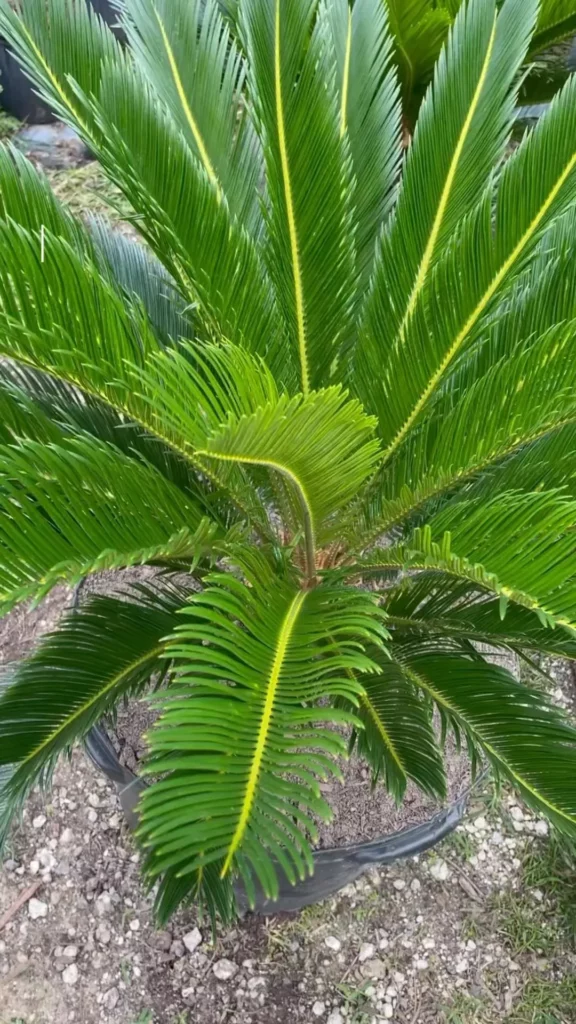


Proper watering is crucial for the health and vitality of your Sago Palm. These plants thrive in well-draining soil, so it’s important to ensure that excess water can easily escape. Overwatering can lead to root rot and other issues, so it’s best to allow the soil surface to dry out between waterings. This prevents waterlogged conditions and encourages healthy root growth.
Sago palms have some drought tolerance but prefer to be kept moderately moist. The frequency of watering will depend on factors such as climate, humidity, and pot size. In general, it’s a good practice to water deeply but infrequently, allowing the water to penetrate the soil and reach the plant’s roots.
In the winter when the Sago Palm is not actively growing, you can reduce the frequency of watering as the plant requires less moisture. However, it’s important to monitor the soil’s moisture level and avoid letting it completely dry out.
No products found.
Signs of Underwatering and Overwatering
It’s essential to pay attention to your Sago Palm’s watering needs in order to prevent both underwatering and overwatering. Here are some signs to look out for:
- If the fronds start turning yellow or brown, it may be a sign of underwatering. In this case, increase the amount and frequency of watering to provide sufficient moisture.
- If the leaves become wilted, yellowing, or mushy, it indicates overwatering. Reduce the frequency of watering and ensure that the soil has proper drainage to prevent water from pooling.
| Watering Tips for Sago Palms |
|---|
| Use well-draining soil mix to prevent waterlogging. |
| Water deeply but infrequently to encourage healthy root growth. |
| Allow the soil surface to dry out between waterings to avoid overwatering. |
| Monitor the plant’s water needs based on climate, humidity, and pot size. |
| Reduce watering frequency in winter, but avoid letting the soil completely dry out. |
Fertilizing Sago Palms
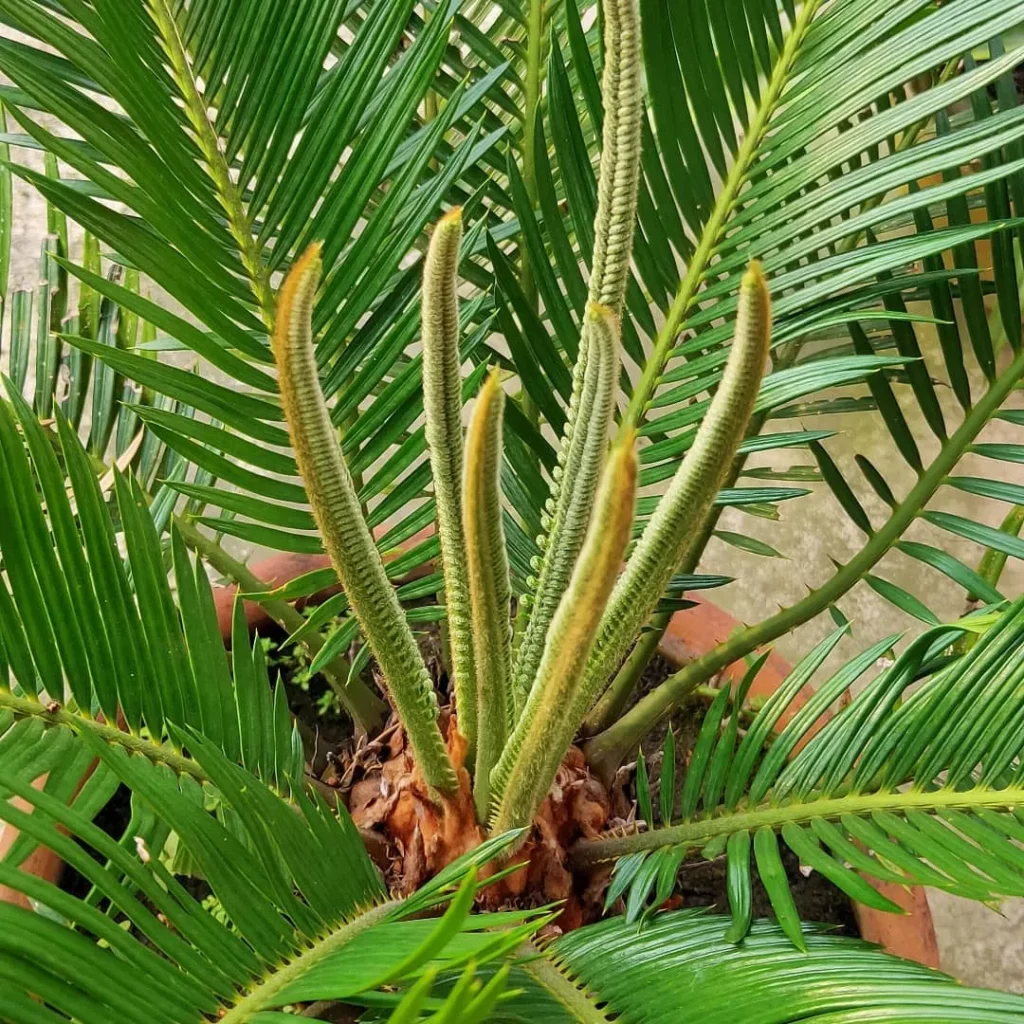
Proper fertilization is essential for the healthy growth and development of Sago Palms. By providing the right nutrients, you can ensure that your Sago Palm flourishes and maintains its stunning appearance. Here are some tips for fertilizing your Sago Palms:
- Frequency: Fertilize your Sago Palms once a month during the growing season, which typically occurs from spring to fall. This regular fertilization schedule will supply the necessary nutrients to support the plant’s growth.
- Liquid Fertilizer: Liquid fertilizers, such as those specifically formulated for palm trees, are suitable for Sago Palms. These fertilizers are fast-acting and get readily absorbed by the roots, providing immediate nourishment to the plant.
- Balanced Ratio: Look for a liquid fertilizer with a balanced ratio of nutrients, such as 18-8-18 (nitrogen-phosphorus-potassium). This balanced ratio ensures that your Sago Palm receives a well-rounded mix of essential elements for optimal growth and vitality.
- Slow-Release Fertilizer: Alternatively, you can use a slow-release fertilizer specifically designed for palm trees. These types of fertilizers release nutrients gradually over an extended period, reducing the frequency of application to two or three times per season.
- Package Instructions: Always follow the package instructions when applying fertilizers to your Sago Palms. Over-fertilizing can lead to nutrient imbalances and potentially harm the plant. Stick to the recommended dosage to avoid any adverse effects.
- Timing: It’s best to fertilize your Sago Palms right before a rain shower or a watering session. This ensures that the nutrients are properly distributed throughout the soil and absorbed by the plant’s roots.
Note: Always refer to the packaging labels and individual plant needs for specific fertilization instructions customized to your Sago Palms.
Potting Sago Palms
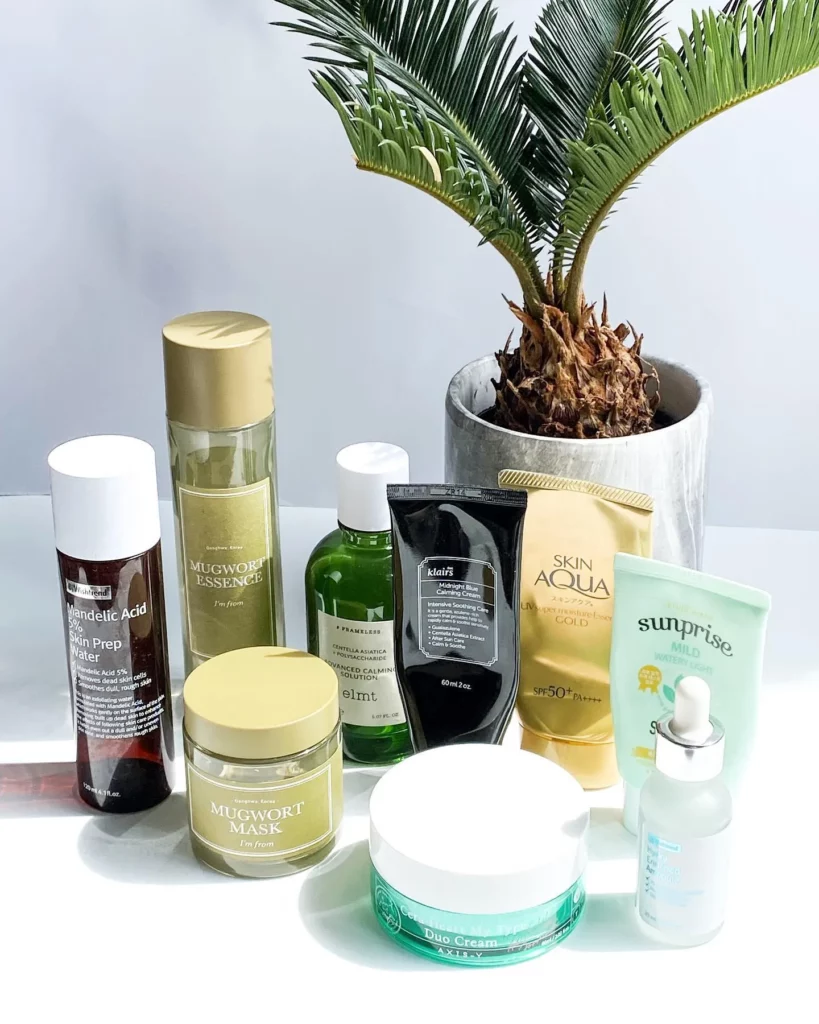

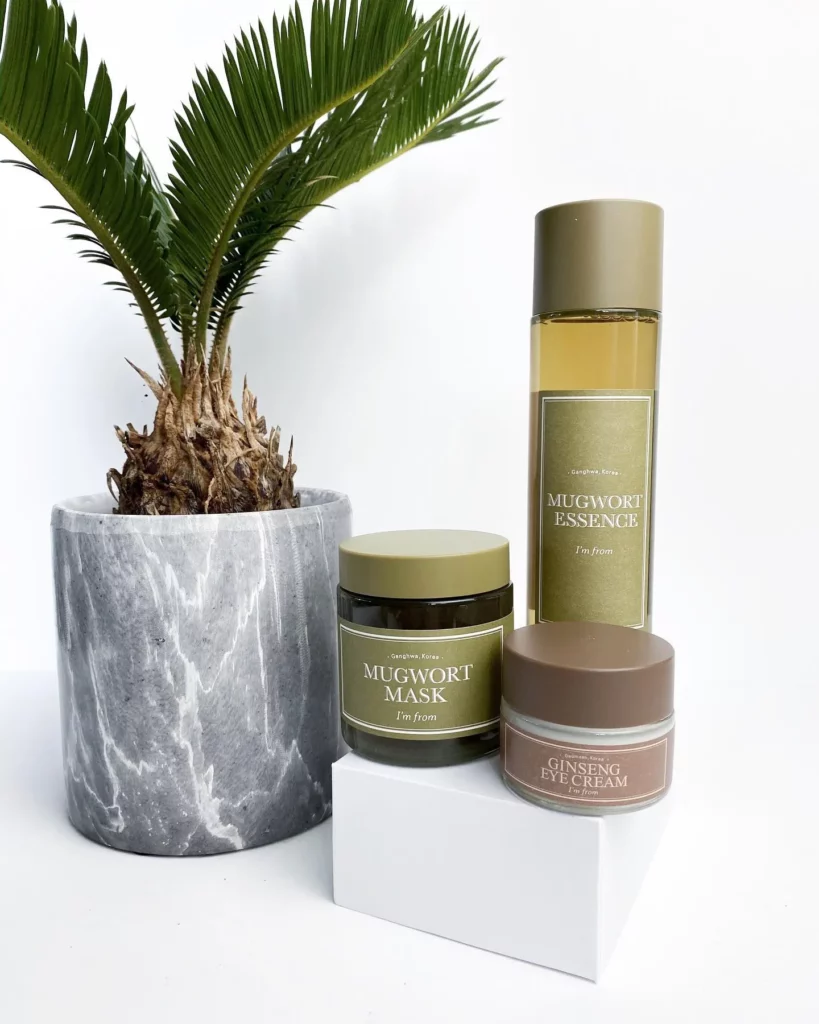
When it comes to potting your Sago Palms, proper care and attention to detail can make all the difference. The right pot and soil mix are essential for the health and growth of your palm. Here are some essential tips to keep in mind:
No products found.
- Choose a porous pot: Opt for a porous pot, such as an unglazed terra cotta pot, that allows excess moisture to evaporate easily. This helps to prevent waterlogging and promote healthy root growth. Plus, it adds to the aesthetic appeal of your palm.
- Ensure ample drainage holes: Proper drainage is crucial for Sago Palms. Make sure your chosen pot has sufficient drainage holes to prevent water from accumulating at the bottom. This helps to prevent root rot and other moisture-related issues.
- Select the right soil mix: Sago Palms thrive in well-draining soil that is slightly acidic. Use a soil mix specially formulated for cacti or palms. This type of soil provides the perfect balance of moisture retention and drainage, allowing the roots to access the nutrients they need.
- Perfect for container gardening: Sago Palms are excellent container plants, whether you choose to keep them indoors or outdoors. Their slow growth rate and compact size make them ideal for adding a touch of tropical beauty to your patio, balcony, or indoor space.
- Repotting considerations: Sago Palms typically only require repotting every three years or so, unless they become rootbound. Keep an eye on the root system and consider repotting if the roots are tightly packed and circling the pot. This allows the palm to continue growing without being restricted by limited space.
Propagation of Sago Palms

If you want to expand your collection of Sago palms or share these beautiful plants with others, there are two primary methods of propagation to consider: offset division and planting seeds.
Offset Division
Propagation by offset division is the quicker and easier method for multiplying your Sago palms. Offsets, also known as pups, are small baby plants that grow at the base of the parent plant. To propagate through offset division, follow these steps:
- Identify a healthy Sago palm with well-established offsets.
- Gently dig around the base of the parent plant and carefully separate the offsets from the main root ball.
- Prepare a new pot or planting area with well-draining soil.
- Plant each offset separately, making sure their roots are well-covered with soil.
- Water the newly planted offsets and provide regular care, including proper watering and light conditions, to promote strong root growth.
Offset division is best done in early spring or late fall when the Sago palm is not actively growing. With proper care, the offsets will establish themselves and develop into mature plants.
Planting Seeds
If you have the time and patience, Sago palms can also be propagated from seeds. However, it’s important to note that this method is lengthier and less predictable compared to offset division. Here’s what you need to do:
- Soak the Sago palm seeds in warm water for 24 to 48 hours to help break their dormancy.
- Prepare a shallow tray or pot with a well-draining soil mix.
- Plant the seeds about an inch deep into the soil, ensuring they are evenly spaced apart.
- Place the tray or pot in a warm and moist environment, such as a greenhouse or a covered area, to maintain consistent temperature and humidity.
- Provide regular misting to keep the soil moist but not waterlogged.
- Be patient, as germination can take several months.
Propagation through seeds requires careful monitoring and maintenance of the growing conditions. It’s important to note that not all seeds may germinate successfully, and the resulting plants may exhibit variations in characteristics compared to the parent plant.
Remember, whether you choose offset division or planting seeds, providing proper care and attention is crucial for the successful propagation of your Sago palms. With time and patience, you can expand your collection and enjoy the beauty of these timeless plants.
Growth and Development of Sago Palms

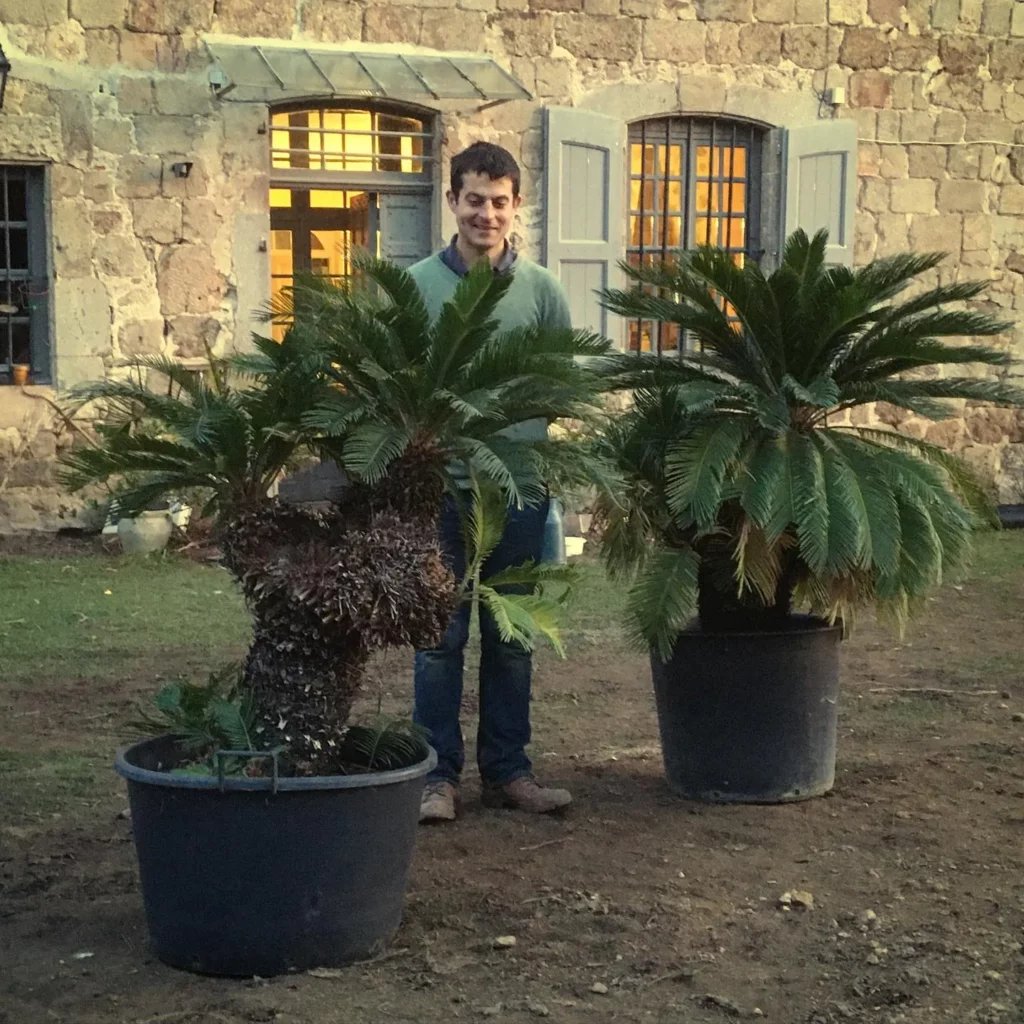
Sago palms are known for their slow-growing nature, gradually gaining only a few inches in height each year. This deliberate growth rate contributes to their resilience and longevity, allowing them to thrive in various environments.
The height of a mature Sago Palm can reach an impressive 10 feet or more, but it can take up to 50 years to achieve this height. Each frond unfurls slowly, adding to the plant’s stature over time. This gradual growth is a testament to the Sago Palm’s resilience and ability to adapt to its surroundings.
What makes Sago Palms even more remarkable is their lifespan. These enduring plants have the potential to live for over 200 years, making them a truly remarkable addition to any landscape or indoor space.
The growth rate of Sago Palms is influenced by several factors, including sunlight, temperature, and proper care. Providing the right conditions, such as adequate light and optimal temperatures, promotes healthy growth and development. Additionally, consistent care, including regular watering, fertilizing, and maintenance, helps support the plant’s growth potential.
Overall, Sago Palms are cherished for their slow-growing nature, height potential, and impressive lifespan. Whether you choose to cultivate them indoors or outdoors, these long-lived plants bring beauty and resilience to any setting.
| Sago Palm Growth and Development | Description |
|---|---|
| Growth Rate | Slow-growing, gaining a few inches in height each year |
| Maximum Height | Can reach 10 feet or more, but it can take up to 50 years |
| Lifespan | Known to live for over 200 years or more |
| Influencing Factors | Sunlight, temperature, and proper care |
Pests and Diseases of Sago Palms
Sago palms are generally hardy and resilient plants, but they are not completely immune to pests and diseases.
One common pest that can affect Sago Palms is scale bugs. These small, oval-shaped pests attach themselves to the fronds and trunk, sucking the sap from the plant. To control scale bugs, you can use insecticides specifically formulated for them or introduce natural predators like ladybugs or lacewings.
Spider mites are another common pest that can infest Sago Palms. These tiny pests can cause significant damage by puncturing the plant cells and sucking out their contents. Regularly inspect your plants for spider mites, and if detected, you can use insecticidal soap or neem oil to control them.
No products found.
Root rot is a common disease that can affect Sago Palms, especially when they are overwatered or grown in poorly draining soil. To prevent root rot, ensure that the soil is well-draining and that the plant is not sitting in water. It’s essential to water your Sago Palm properly by allowing the soil surface to dry out between waterings.
Yellowing leaves can be a sign of various issues, including nutrient deficiencies or insect infestations. If you notice yellowing leaves on your Sago Palm, check for signs of pests like scale bugs or spider mites. Additionally, ensure that your plant is receiving adequate nutrition by fertilizing it correctly. If the problem persists, consult with a local horticulturist or plant specialist for further guidance.
FAQ
How do I care for my Sago Palm?
Caring for a Sago Palm is relatively easy. It requires warm, humid conditions, dappled sunlight, acidic soil, and consistent temperatures between 65 and 75 degrees Fahrenheit. It is important to note that all parts of the plant are toxic to humans and pets.
What does a Sago Palm look like?
Sago Palms have long green fronds that grow in a symmetrical ring from a non-branching trunk. The leaves are spiky, glossy, and dark green in color. New growth starts with bronze, feather-like foliage. When grown in the ground, they can reach heights of 10 feet or more, but when grown in containers, they tend to stay smaller, usually around 2 to 3 feet.
What are the light requirements for Sago Palms?
Sago Palms prefer bright, indirect light and can tolerate some direct sunlight. Indoors, they should be placed near east-, west-, or south-facing windows to receive adequate light. Outdoors, they should be placed in a sunny spot with partial shade to protect the leaves from scorching. Too much shade can result in sparse foliage.
How often should I water my Sago Palm?
Sago Palms prefer well-draining soil and should be watered when the surface of the soil dries out. It’s important to avoid overwatering, as it can lead to root rot. The frequency of watering will vary depending on factors such as climate, humidity, and pot size.
How should I fertilize my Sago Palm?
Sago Palms should be fertilized monthly during the growing season with a liquid fertilizer or using slow-release fertilizer two to three times per season. A balanced ratio of 18-8-18 (nitrogen-phosphorus-potassium) is recommended. Over-fertilizing should be avoided as it can lead to nutrient imbalances.
What kind of pot should I use for my Sago Palm?
Sago Palms should be planted in a porous pot with ample drainage holes to ensure proper drainage. Unglazed terra cotta pots are suitable as they allow excess moisture to evaporate easily. A well-draining soil mix made for cacti or palms is recommended.
How can I propagate my Sago Palm?
Sago Palms can be propagated through division or by planting seeds. Propagation through division is the quicker and easier method, while propagation through seeds is a longer and less reliable process.
How long does it take for a Sago Palm to grow?
Sago Palms are slow-growing plants, gaining only a few inches in height each year. It can take up to 50 years for them to reach their maximum height of 10 feet or more. However, they are known to live up to 200 years or more.
Are Sago Palms prone to pests and diseases?
Sago Palms are relatively pest and disease resistant, but they can still encounter problems. Common pests include scale bugs and spider mites, while root rot can occur if the plant is overwatered or planted in poorly draining soil. Yellowing leaves can be caused by nutrient deficiencies or insect infestations.





I have sago plant so always bear much young trees so I want to take young ones out for selling where can I sell them
To sell your young Sago Palm trees, try contacting local plant nurseries, use online marketplaces like eBay or Craigslist, and utilize social media platforms such as Facebook Marketplace and gardening groups to find potential buyers in your area. Be sure to provide clear descriptions and photos of the plants when advertising them for sale.
I just purchased two (2) seeds-it recommended sanding prior to soaking. What parts of the seeds would be sanded?
To improve germination rates for sago palm seeds, gently sand a small area of the seed coat with fine sandpaper or an emery board. This helps water penetrate the seed coat. After scarifying, soak the seeds in warm water for a day or two before planting in well-draining soil.
I had the most gorgeous saga palm living in California, moved to Az. And now I believe it has died, I mist it kept out of the sun, all the leaves are gone and just a trunk now, bottom part is dark and the top is light brown, had a regrow on top but has been brown for a very long time now, I’m so sad I have had this palm for 30 years